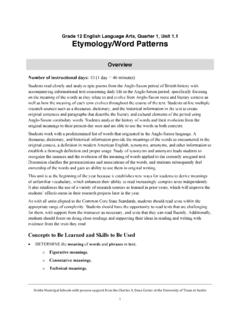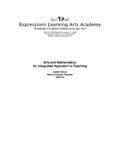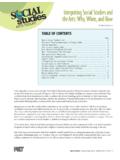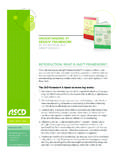Transcription of English Language Arts (ELA) Grade Level: 3
1 2009 New Jersey Curriculum ProjectAligned to the 2009 New Jersey Core Curriculum Content StandardsENGAGING STUDENTS FOSTERING ACHIEVEMENT CULTIVATING 21ST CENTURY GLOBAL SKILLS Brooklake Elementary School Grade 3 Content Area: English Language arts Grade 3 Course Title: English Language arts (ELA) Grade Level: 3 Reading (to unit introduction) Pacing GuideWriting(to unit introduction)Pacing GuideLanguage(to unit introduction)Pacing GuideSpeaking and ListeningReferenceDate Created:Board Approved on:Created for New Jersey school districts through a project of the New Jersey Department of Education, Office of Academic Standards,in partnership with the Association for Supervision and Curriculum Development and the Principals and Supervisors New Jersey Curriculum ProjectAligned to the 2009 New Jersey Core Curriculum Content StandardsENGAGING STUDENTS FOSTERING ACHIEVEMENT CULTIVATING 21ST CENTURY GLOBAL SKILLSI ntroduction Reading is thinking, (Fountas and Pinnell, 2006) and if we think, therefore we are.
2 Logic then tells us that reading determines who we are. How do we tell the world who we are? Through writing and speaking. How do we learn who others are? Through careful listening. This is the heart of the English Language arts common core standards and the curriculum put forth in this document. The power of words, both written and spoken, cannot be underestimated. There are the soothing words of lullabys and poetry, the inspirational words of great speeches, the call to action of persuasive text. Every thought and emotion can be conveyed through words. Words, especially written, take center stage in the 21st century as never before. Casual communication, once the domain of telephones and face-to-face conversation, often takes place in cyberspace via text messages, emails, Facebook, and Twitter.
3 The limits of text messages (160 characters) and Tweets (140 characters) make it imperative that meaning comes across loud and clear. Email is prevalent in the business world, and it is imperative that one s writing be precise. On the flip side of composing effective written communication, is reading and comprehending these messages. The curriculum offered here teaches students to create meaning from what they read. Students will be explicitly taught to apply reading comprehension strategies to various types of text. Students will learn the structure of texts to be able to create meaning while reading and when writing. Grammar, mechanics, and vocabulary instruction will add to the student s ability to create meaning for the reader when they write, and for themselves when they read.
4 Students will spend time reading independently and extensively to build background knowledge and vocabulary. Students will be expected to engage with the texts they read and provide evidence of that engagement in reader s for New Jersey school districts through a project of the New Jersey Department of Education, Office of Academic Standards,in partnership with the Association for Supervision and Curriculum Development and the Principals and Supervisors New Jersey Curriculum ProjectAligned to the 2009 New Jersey Core Curriculum Content StandardsENGAGING STUDENTS FOSTERING ACHIEVEMENT CULTIVATING 21ST CENTURY GLOBAL SKILLSE nglish Language arts (ELA) Grade 3 Content Area: Reading(back)Course Title: English Language arts (ELA): ReadingGrade Level.
5 3 Reading LiteraturePacing GuideReading Informational TextPacing GuideThe Reader s NotebookPacing GuideReading Foundational SkillsReferenceProject ReadReference Created for New Jersey school districts through a project of the New Jersey Department of Education, Office of Academic Standards,in partnership with the Association for Supervision and Curriculum Development and the Principals and Supervisors New Jersey Curriculum ProjectAligned to the 2009 New Jersey Core Curriculum Content StandardsENGAGING STUDENTS FOSTERING ACHIEVEMENT CULTIVATING 21ST CENTURY GLOBAL SKILLS Curriculum DesignContent Area: English Language arts (back)Course Title: English Language arts (ELA): Reading LiteratureGrade Level: 3 Reading Strategies Pacing GuideGenre Study.
6 Elements of the Genre Pacing GuideReading SkillsPacing GuideReading Standards for LiteratureReferenceBook ReportsPacing GuideLiterature Circles Pacing GuideGuided Reading Pacing GuideRequired (Core) Anthology SelectionsReferenceCreated for New Jersey school districts through a project of the New Jersey Department of Education, Office of Academic Standards,in partnership with the Association for Supervision and Curriculum Development and the Principals and Supervisors New Jersey Curriculum ProjectAligned to the 2009 New Jersey Core Curriculum Content StandardsENGAGING STUDENTS FOSTERING ACHIEVEMENT CULTIVATING 21ST CENTURY GLOBAL SKILLSC reated for New Jersey school districts through a project of the New Jersey Department of Education, Office of Academic Standards,in partnership with the Association for Supervision and Curriculum Development and the Principals and Supervisors Association.
7 Reading Strategies Grade 3 Content Area: English Language arts (back)Course Title: English Language arts (ELA): Reading StrategiesGrade Level: 3 Monitoring Comprehension Pacing GuideMaking Connections Pacing GuideQuestioning Pacing GuideVisualizingPacing GuideInferring Pacing GuideSummarizingPacing GuideTable: Journeys lessons by reading strategy2009 New Jersey Curriculum ProjectAligned to the 2009 New Jersey Core Curriculum Content StandardsENGAGING STUDENTS FOSTERING ACHIEVEMENT CULTIVATING 21ST CENTURY GLOBAL SKILLSUnit Overview TemplateContent Area: English Language arts (ELA)Unit Title: Reading Grade 3(back)Target Course/ Grade Level: 3 Unit Summary Students in the intermediate grades have already learned to read.
8 At this level, they will read to learn by being taught the reading comprehension strategies and how to apply them to independent reading. Students will be given time in school for independent reading to practice using the strategies they are being taught with the guidance of the teacher. Students will respond to what they read by talking with peers in discussion groups and individually with the teacher during conferences as well as writing in reader s notebooks. Students will read broadly and extensively to build background knowledge and increase and improve both their writing and will learn to write narratives, arguments (opinion), and explanatory pieces applying the conventions of standard English grammar, punctuation, and spelling.
9 Students will be expected to support their writing with evidence from text and to create lists of sources. Students will be taught to create and use a writer s notebook to store their observations of the world around them and select topics to write about from these will learn how to prepare for the NJASK and have time to practice under simulated testing interdisciplinary connections: Science, Social Studies, History, Health21st century themes: Global Awareness through reading the literature of other countries, cultures, and civilizations, students will come to recognize that all people regardless of race, nationality, or religion, share the same stories and similar underlying beliefs. Through reading great classic and contemporary works of literature representative of a variety of periods, cultures, and worldviews, students can vicariously inhabit worlds and have experiences much different than their century skills: Creativity and Innovation Critical Thinking and Problem Solving Communication and Collaboration Media Literacy Life and Career SkillsUnit RationaleTo build a foundation for college and career readiness, students must read widely and deeply from among a broad range of high-quality, increasingly challenging literary and informational texts.
10 Through extensive reading of stories, dramas, poems, and myths from diverse cultures and different time periods, students Created for New Jersey school districts through a project of the New Jersey Department of Education, Office of Academic Standards,in partnership with the Association for Supervision and Curriculum Development and the Principals and Supervisors New Jersey Curriculum ProjectAligned to the 2009 New Jersey Core Curriculum Content StandardsENGAGING STUDENTS FOSTERING ACHIEVEMENT CULTIVATING 21ST CENTURY GLOBAL SKILLS gain literary and cultural knowledge as well as familiarity with various text structures and elements. By reading texts in history/social studies, science, and other disciplines, students build a foundation of knowledge in these fields that will also give them the background to be better readers in all content areas.





